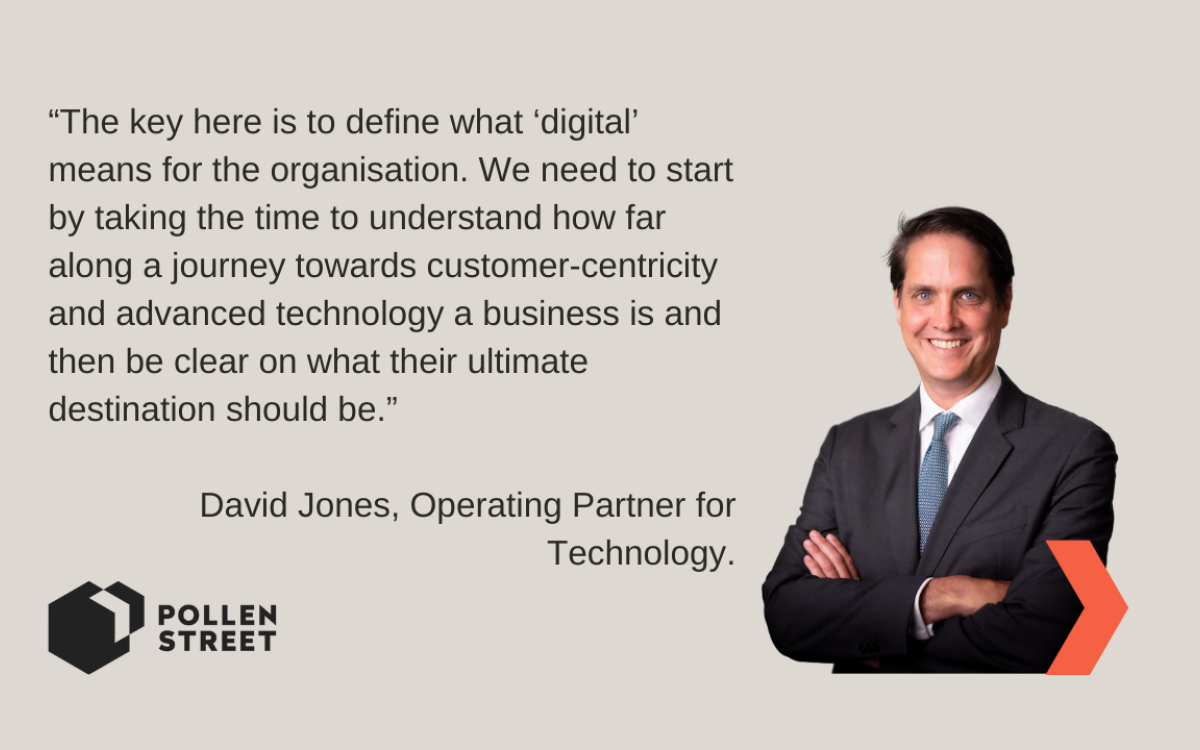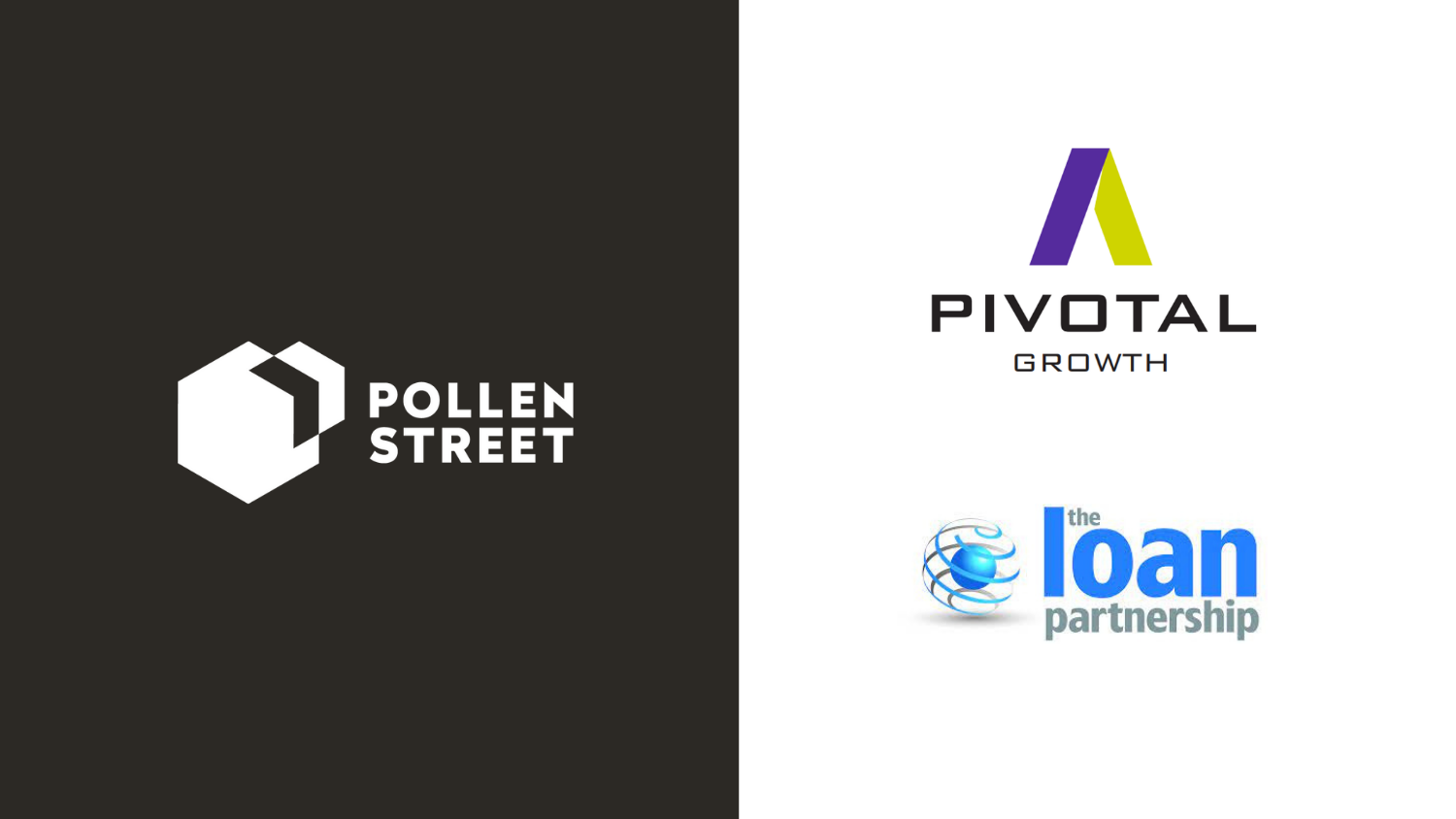
Reframing digital transformation
David Jones, Operating Partner for Technology, brings an 'on-the-ground' view of what digital transformation really looks like
In a webinar hosted by the Pollen Street Capital Hub earlier this year we explored the human element of digital transformation. Through our discussion of digital transformation, we reframed this thinking to ‘business transformation with digital’ which I wanted to take some time to flesh out.
Importantly I want to also bring an ‘on-the-ground’, human, view of what digital transformation really looks like for financial services businesses. There is no ‘one size fits all’ – but I believe we can find common ground on what works, and what does not.
Starting with a definition. In its simplest sense, a digital business relies on technology to operate and grow. Across our portfolio this can mean capturing data to improve business intelligence, leveraging AI or other technology to improve customer experience, and managing business processes digitally or automatically.
What you might see from that definition is that all businesses are digital – just to varying degrees. The key piece of information for me as an Operating Partner for Technology, sitting within a Private Equity firm, is how far along a customer-centric, technology-focused journey a business is.
All organisations aspire to deliver faster and in a more agile way. The vast majority of organisations are thinking about how to orient themselves towards being a customer first, product-led, digital operation.
But it all goes back to the customer, really, and our addressable markets are increasingly digitally native. A colleague shared an anecdote recently illustrating the tidal shift that has already taken place towards digital. Having been given a cheque as a wedding gift she was chatting to her mother about where on earth the nearest bank was to deposit… only to be informed by her incredulous mum ‘you can just do that in the app!’.
My point is that digital isn’t a defined ‘thing’. It is your business. Thinking about it in these terms may well change the way you think about digital transformation.
The right team to transform
If digital is everything and everywhere then who are the leaders in your business who can accelerate change and drive a digital transformation programme?
A good product owner knows the customer inside out. That is the crucial piece of the puzzle they bring to the table, and they should ideally be in a position where they can align the business strategy to a product roadmap.
The Chief Technology Officer can then work in lockstep with the Chief Product Officer to ensure the business is delivering at pace, with customers at the heart of every decision.
In digital transformation we talk a great deal about the importance of hearts and minds, bringing teams with you to break down silos and genuinely change ways of working. Seamless collaboration between product and technology and broader leadership will enable customer-centricity to translate directly into execution through technology and culture change.
The right team can also help tackle one of the great challenges of successful digital transformation - which is the final (and often forgotten when it comes to playbooks) step of eliminating legacy after modernisation. Every approach is different but looking for where efficiencies have been made and therefore where costs can be reduced/come out, and where back-office teams can change is often the biggest organisational challenge in transforming a business.
Harmonising product and technology leadership with clear KPIs for transformation will go a long way to solving for this and ensuring a focus on thoughtfully decommissioning legacy elements of a business. It is often the most difficult element of a transformational agenda, but clearly the piece that unlocks the true business benefits.
Are we agile?
As another reflection on our recent webinar discussion, I’d like to take a moment to look at agile transformation in financial services from a ‘human’ perspective.
With the seismic shift during and following the pandemic towards dispersed workforces, supply chain challenges, and increasingly unpredictable market dynamics, we saw agile ways of working go from a transformation discipline to a business imperative.
Agile requires deeply implementing new ways of working across the whole organization, ensuring the business is firmly centred around the customer, reworking processes to improve agility, increase productivity, and remove cost.
But as we all know, in financial services there are some barriers to an agile transformation that we need to be realistic about. As an example, aspects of the SM&CR regime mean some leaders in financial services are more inclined to steer away from the shared accountability and cross-functional / cross P&L approach that is an essential part of an agile operating model.
Here’s where hearts and minds come back to the forefront. Perhaps even more powerful than the structural model of product owners is the cultural shift across a whole organisation that creates shared objectives and responsibilities. Agreeing to clearly defined principles and KPIs that guide where you realistically want to business to be in 12 months is critical. With those in place you have the right foundation for agile transformation regardless of the challenges specific to your business.
A personal approach to ‘playbooks’
The key here is to define what ‘digital’ means for the organisation. We need to start by taking the time to understand how far along a journey towards customer-centricity and advanced technology a business is and then be clear on what their ultimate destination should be.
A prescriptive approach can embed metrics or set goals that are irrelevant and even waste time on steps that aren’t valuable to the business.
Instead there are some core ideas that should guide transformation:
- Leadership – as mentioned, transformation needs to be driven from the top. Not just the CEO but with a tailored team of product, technology and business leaders.
- Scale – great tools and technology need to be embedded well enough and designed to operate at scale and to grow with the business
- Measurement - Agree metrics that investors and exec committee buy into that are tied to the strategy and investment thesis. This makes tracking easier and aligns all stakeholders
So what does it all mean?
We see digital change across our entire portfolio; in one way or another, every business has an aspiration to be more efficient by taking advantage of new technologies. But whilst the ambition is there, it is often wrought with challenges, both conceptually and tactically.
Change needs to be agreed across leadership, roles and responsibilities needs to be clearly defined and agreed, and finally, business strategy – articulated via a clear product roadmap – will go a long way in achieving results and hearts and minds.

